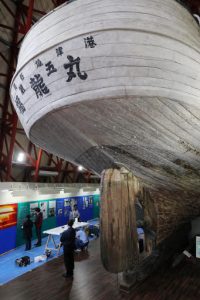Daigo Fukuryu Maru Exhibition Hall to reopen in April after renovations
Mar. 23, 2019
by Michiko Tanaka, Staff Writer
The Daigo Fukuryu Maru Exhibition Hall in Tokyo will reopen on April 2 after undergoing renovations. Constructed by the Tokyo Metropolitan Government in the Yumenoshima Park in Koto Ward, the hall houses the tuna fishing boat that was damaged in the hydrogen bomb test conducted by the United States in 1954. Over the last nine month, while the the exhibition hall was closed, the building was repaired and new contents have been added to the exhibition to better convey the tragedy that was caused by this nuclear bomb. In a new section, visitors can watch a video of a former crew member talking about his experience of the hydrogen bomb test.
The exhibition hall was opened in 1976 in order to preserve the boat, which had been abandoned in Tokyo. This was 22 years after the boat from Yaizu, Shizuoka Prefecture was exposed to radiation from the hydrogen bomb test conducted at Bikini Atoll in the Marshall Islands, located in the Pacific Ocean. In recent years, the hall developed structural problems that included a leaky roof and an uneven floor due to land subsidence, issues that could have resulted in harming the 30-meter-long boat. The metropolitan government allocated 200 million yen to redo the roof, fix the floor, and improve the lighting. The hall has been closed since last July.
The video of the former crew member talking about his experience is the first video made by the exhibition hall to help keep the memories of the crew members alive. Matashichi Oishi, 85, who was one of the crew members and worked in the freezing section of the boat, tells what happened at the moment of the nuclear test and about the days afterward when he was forced to live with the fear of death. With the passing of Susumu Misaki, who was a steersman on the boat, this past February at the age of 92, Mr. Oishi and three others are now the only members of the crew who are still alive.
Visitors are not permitted to go into the boat itself, but they can view an eight-minute three-dimensional image of the interior, which is one of the new exhibits. Shot with a special camera, this image shows the inside of the boat’s radio communication room, the fish storage hold, and other locations. More detailed English explanations are now provided and English pamphlets have been made available for visitors from overseas.
Kazuya Yasuda, 66, the head curator of the exhibition hall, said, “The hall now provides an excellent environment for the preservation of this important vessel. I hope the museum can send out more messages about the kind of tragedies that nuclear weapons can cause.” The museum is open between 9:30 a.m. and 4:00 p.m., but is closed on Mondays. Admission is free. For further information, call 03-3521-8494.
(Originally published on March 23, 2019)
The Daigo Fukuryu Maru Exhibition Hall in Tokyo will reopen on April 2 after undergoing renovations. Constructed by the Tokyo Metropolitan Government in the Yumenoshima Park in Koto Ward, the hall houses the tuna fishing boat that was damaged in the hydrogen bomb test conducted by the United States in 1954. Over the last nine month, while the the exhibition hall was closed, the building was repaired and new contents have been added to the exhibition to better convey the tragedy that was caused by this nuclear bomb. In a new section, visitors can watch a video of a former crew member talking about his experience of the hydrogen bomb test.
The exhibition hall was opened in 1976 in order to preserve the boat, which had been abandoned in Tokyo. This was 22 years after the boat from Yaizu, Shizuoka Prefecture was exposed to radiation from the hydrogen bomb test conducted at Bikini Atoll in the Marshall Islands, located in the Pacific Ocean. In recent years, the hall developed structural problems that included a leaky roof and an uneven floor due to land subsidence, issues that could have resulted in harming the 30-meter-long boat. The metropolitan government allocated 200 million yen to redo the roof, fix the floor, and improve the lighting. The hall has been closed since last July.
The video of the former crew member talking about his experience is the first video made by the exhibition hall to help keep the memories of the crew members alive. Matashichi Oishi, 85, who was one of the crew members and worked in the freezing section of the boat, tells what happened at the moment of the nuclear test and about the days afterward when he was forced to live with the fear of death. With the passing of Susumu Misaki, who was a steersman on the boat, this past February at the age of 92, Mr. Oishi and three others are now the only members of the crew who are still alive.
Visitors are not permitted to go into the boat itself, but they can view an eight-minute three-dimensional image of the interior, which is one of the new exhibits. Shot with a special camera, this image shows the inside of the boat’s radio communication room, the fish storage hold, and other locations. More detailed English explanations are now provided and English pamphlets have been made available for visitors from overseas.
Kazuya Yasuda, 66, the head curator of the exhibition hall, said, “The hall now provides an excellent environment for the preservation of this important vessel. I hope the museum can send out more messages about the kind of tragedies that nuclear weapons can cause.” The museum is open between 9:30 a.m. and 4:00 p.m., but is closed on Mondays. Admission is free. For further information, call 03-3521-8494.
(Originally published on March 23, 2019)








